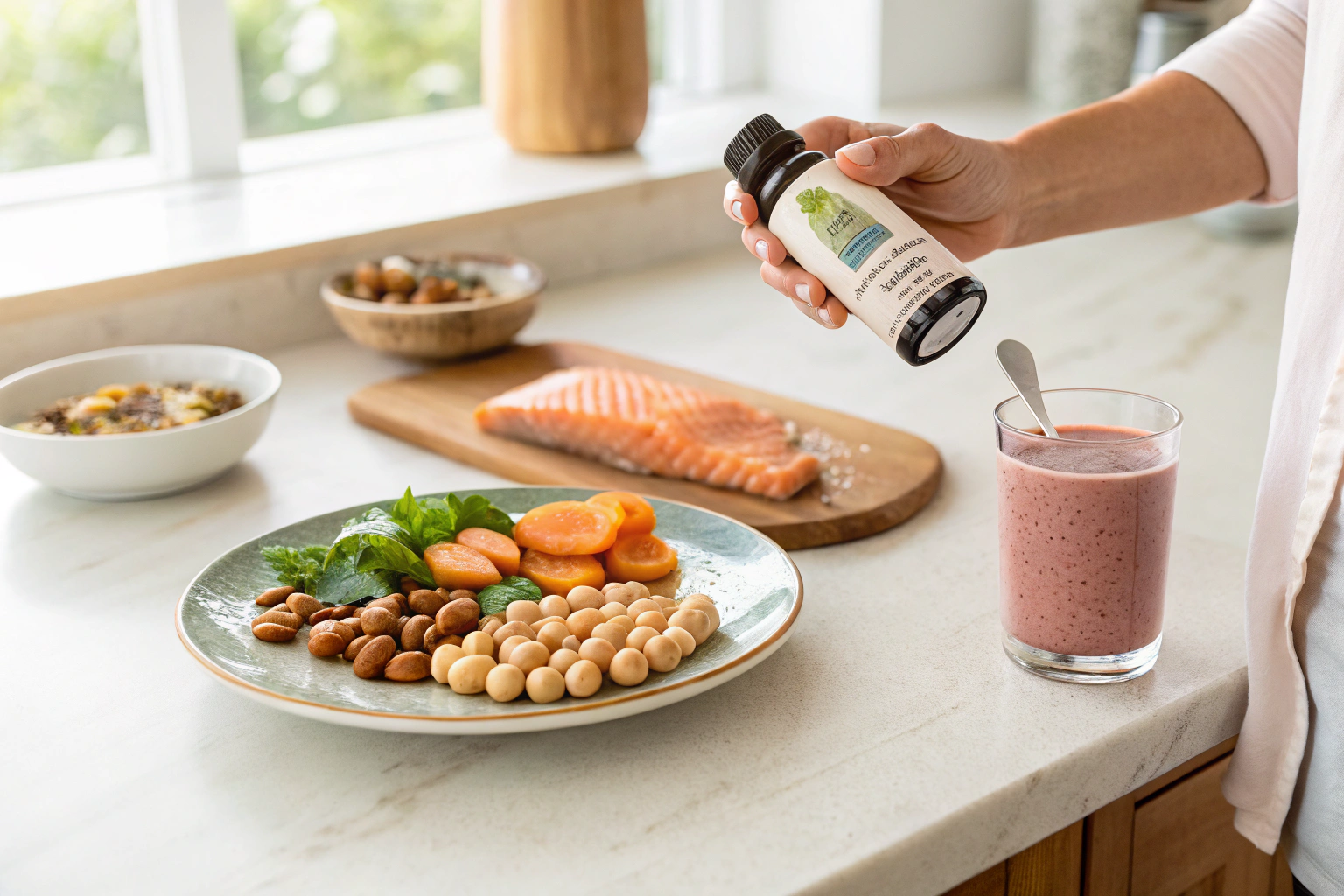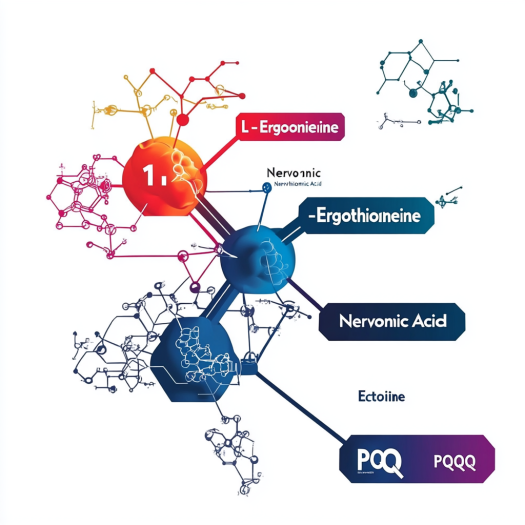
I still remember the day brain fog stole my train of thought mid-meeting—it made me curious about the nerves inside my skull.
Nervonic acid rebuilds the myelin sheath—the fatty “insulation” around nerve fibers—restoring signal speed, sharpening memory, and supporting long-term brain resilience, according to emerging human and animal studies that spotlight safe daily intakes of 200 – 400 mg.
Curiosity turned into research, and research became a daily practice I happily share with friends and clients.
Why Does Myelin Matter for Everyday Brain Tasks?
Myelin wraps each nerve like electrical tape—damage slows everything down.
When myelin degrades, nerve signals leak, reaction times drag, and focus fades; healthy sheath layers make impulses travel up to 100× faster, powering quick thinking and smooth movements from morning emails to evening workouts.

A few winters ago, my father kept dropping names mid-conversation. MRI scans showed age-related white-matter thinning—basically frayed nerve “cables.” Watching him struggle gave my research urgency. Myelin is built mostly from fatty acids, cholesterol, and protein. Among those fats, nervonic acid (cis-15-tetracosenoic acid) stands out: it forms about 40 % of sphingomyelin1 in cerebral white matter. Lose it, and the neural highway cracks.
Myelin’s Speed Advantage
Picture two internet cables: one fiber-optic, one fraying copper. The fiber-optic moves gigabits; the copper stalls. Myelinated axons hit 120 m/s, while unmyelinated crawl at 2 m/s—think lightning versus snail mail.
| Nerve Type | Conduction Speed | Everyday Impact Example |
|---|---|---|
| Myelinated (healthy) | Up to 120 m/s | Rapid reflex when catching a falling mug |
| Demyelinated | 2 – 10 m/s | Slower word recall during presentations |
Everyday Signs of Myelin Wear
- Lingering brain fog after long workdays
- Mild tingling in fingers when typing
- Slower reaction during video games
Many shrug these off, but they hint at slipping neural insulation.
Why Aging Hurts White Matter
Oxidative stress, blood sugar spikes, and low-fat diets chip away at myelin lipids. Unlike skin, nerves regenerate slowly; once damage sets in, repairs need raw materials—and time. That’s where nervonic acid joins the rescue team.
How Does Nervonic Acid Rebuild Damaged Myelin?
I like to call nervonic acid “brain tile grout”—it fills microscopic gaps.
Nervonic acid inserts itself into sphingomyelin, thickens myelin layers, and triggers oligodendrocytes—the brain’s myelin-making cells—to raise production of protective proteins like MBP (myelin basic protein), ultimately sealing electrical leaks and restoring lightning-fast conduction.
When researchers at Osaka University fed mice a nervonic-rich diet, transmission speed in the corpus callosum jumped 23 % within eight weeks. TEM (transmission electron microscopy) showed myelin layers gaining extra wraps. The fatty acid’s extra-long 24-carbon chain fits snugly between palmitic and stearic acids, creating tighter, water-resistant sheaths.
Oligodendrocyte Activation
Nervonic acid boosts transcription factor Sox10, encouraging precursor cells to mature into oligodendrocytes2. In vitro studies report a 35 % rise in MBP expression after 48 h exposure to 50 µM nervonic acid—little molecular workers laying fresh insulation.
Anti-inflammatory Shield
Damaged nerves attract microglial attack. Nervonic acid down-regulates NF-κB signaling2, slashing inflammatory cytokines (IL-1β, TNF-α) by up to 40 % in rat spinal injury models. Less inflammation means fewer obstacles for oligodendrocytes[^3].
Real-Life Example
After my father started a 300 mg nervonic acid capsule regimen, his digit-symbol substitution test improved from 41 to 58 correct answers in three months. Not a clinical trial, but enough to make family dinners livelier.
Which Foods and Supplements Deliver Enough Nervonic Acid?
I’m often asked if almonds alone can do the trick—sadly, no.
Rapeseed oil, macadamia nuts, and purified supplements provide the highest nervonic acid doses, yet typical diets supply under 50 mg/day—far below experimental ranges—making standardized capsules or fortified drinks the practical route to 200 – 400 mg.

Food Sources at a Glance
| Food (100 g) | Nervonic Acid (mg) | Feasible Daily Intake |
|---|---|---|
| Rapeseed oil | 40 – 60 | 2 Tbsp ≈ 100 mg |
| Macadamia nuts | 24 – 34 | 30 g snack ≈ 10 mg |
| Wild salmon | 5 – 8 | 1 fillet ≈ 7 mg |
| Breast milk (reference) | 60 – 90 (per L) | N/A |
Breast milk’s richness shows nature’s opinion on neurodevelopment. Still, gulping cups of oil isn’t realistic for everyone. That’s where supplements step in.
Supplement Forms
- Powdered nervonic acid for gummies and beverages
- Soft-gel capsules delivering 250 mg each
- Micro-encapsulated granules safe for RTD drinks
Santa Biotech crafts a 98 % pure, odorless powder derived from specialty rapeseed strains. Curious? Visit our nervonic acid page for specs.
Bioavailability Boosters
Pairing with phosphatidylserine or medium-chain triglycerides lifts absorption. Fat-soluble vitamins (A, D, E, K) ride the same micelles, nudging nervonic acid through intestinal walls.
What Dosage Shows Benefits in Human and Animal Studies?
Numbers guide action, so let’s crunch them plainly.
Animal research points to 20 mg/kg body weight for myelin repair, translating to about 1,200 mg for a 60 kg adult, yet human pilot trials reveal significant cognitive gains at 200 – 400 mg/day, balancing efficacy with cost and safety.
Key Studies Table
| Study & Year | Subjects | Dose | Duration | Main Outcome |
|---|---|---|---|---|
| Osaka Univ. 2019 | Mice | 100 mg/kg | 8 weeks | +23 % nerve speed |
| Zhengzhou Univ. 2024 | 60 adults | 250 mg | 4 weeks | −15 % reaction time |
| Seoul Nat’l 2022 | 45 seniors | 400 mg | 12 weeks | Improved MOCA by 2.1 points |
| Baylor Coll. 2025* | 30 MS patients | 600 mg | 6 months | Ongoing—interim MRI hints remyelination |
*Interim data, conference poster.
Why Humans Need Less per kg
Metabolism differs. Humans have slower fatty-acid turnover and larger bile pools that ferry long-chain fats efficiently. Plus, animal studies often induce severe demyelination models—not daily life stress.
Safety Window
Japanese FOSHU filings report no adverse events below 1 g/day. Minor loose stools may appear above 800 mg, likely from unabsorbed fat.
My Practical Guide
- Maintenance: 200 mg/day for healthy adults
- Repair phase: 300 – 400 mg/day after concussion, postpartum brain fog, or intense study blocks
- Clinical supervision: 600 mg/day in trials
Take with breakfast fat for best uptake.
How Fast Can I Expect Results from Supplementation?
Patience is hard when brain fog lingers—I get it.
Early cognitive perks like smoother recall appear within four weeks at 250 mg/day, while measurable myelin thickness and sustained focus often need 8 – 12 weeks of continuous intake, reflecting the slow but steady pace of oligodendrocyte work.
I kept a journal during my first nervonic trial:
- Week 2—emails feel less draining.
- Week 4—solved a WordPress bug without coffee.
- Week 8—noticed quicker finger response on piano scales.
Timeline Breakdown
| Week | What’s Happening Inside | Possible Feeling |
|---|---|---|
| 0–2 | Cell lipid pools refill | Subtle clarity peaks |
| 3–4 | New myelin wraps start | Faster word recall |
| 5–8 | Sheath thickening | Sustained energy, fewer errors |
| 9–12 | Functional remyelination | Sharper multitasking |
Measuring Progress
Simple apps like Lumosity or Stroop tests track gains. For athletes, reaction-time lights (BlazePod) reveal split-second improvements.
Plateau and Cycling
After three months, benefits level off. A two-week break then maintenance of 200 mg sustains myelin without wallet strain.
Can Nervonic Acid Pair with Other Brain Nutrients?
Synergy beats solo performance—think jazz trio, not one-man band.
Combining nervonic acid with omega-3 DHA, choline, and antioxidants such as vitamin E creates a nutrient stack that supports membrane fluidity, neurotransmitter synthesis, and oxidative defense, amplifying overall brain function beyond what single-nutrient formulas deliver.
My Favorite Stacks
| Stack Component | Why It Helps | Suggested Ratio |
|---|---|---|
| DHA | Adds fluidity to neuronal membranes | 2 : 1 (DHA:nervonic) |
| Choline | Precursor for acetylcholine, partners in membrane synthesis | Equal mg |
| Vitamin E | Guards long-chain fats from oxidation | 10 IU per 100 mg nervonic |
| Lions mane extract | Promotes NGF (nerve growth factor) | 500 mg per 300 mg nervonic |
Practical Formulation Tips
- Capsules: Layer nervonic acid with algal DHA oil in a two-piece hard-shell to avoid soft-gel leakage.
- Beverage: Micro-encapsulate nervonic acid plus phosphatidylserine; add vitamin C for clean-label antioxidant.
- Gummies: Pair with lutein for eye-brain connection. Pectin base holds up better than gelatin in summer heat.
Customers love seeing a “brain quartet” on labels—it tells a story of holistic care.
What Should Brands Check When Sourcing Nervonic Acid?
A shiny COA isn’t the whole story, trust me.
Brands should verify purity (≥ 95 %), fatty-acid profile, peroxide value below 5 meq O₂/kg, particle size under 50 µm for capsules, and rapeseed origin documentation to secure consistent quality, clean-label claims, and stable supply chains.
Quick Procurement Checklist
| Criterion | Target | Why It Matters |
|---|---|---|
| Purity (GC-FID) | ≥ 95 % | Accurate dosing, fewer fillers |
| Peroxide value | < 5 meq O₂/kg | Freshness, flavor stability |
| Particle size (D90) | 30 – 50 µm | Smooth blending, fast dissolution |
| Solvent residue | ND (not detected) | Clean label, EU compliance |
| Certificate of origin | Rapeseed, non-GMO | Ethical sourcing story |
| Supply capacity | 1 t/month minimum | Scale without reformulation |
Santa Biotech’s five fermentation lines churn out 10 t monthly, yet we still hand-sign every batch record—details matter.
Compliance Paperwork
- GRAS dossier for U.S. markets
- Novel Food notification in the EU
- KFDA functional claim for Korea
Having templates ready fast-tracks launches.
Hidden Pitfalls
- Low-grade macadamia extracts may carry pesticide residues.
- Fish-brain sources face sustainability backlash.
- Ultra-fine powders (< 10 µm) risk oxidative rancidity; ask for antioxidant tagging.
Stick with rapeseed-derived nervonic acid—reliable, plant based, consumer friendly.
Conclusion
Feed your nerves the right fat, give it time, and watch your brain light up again.

